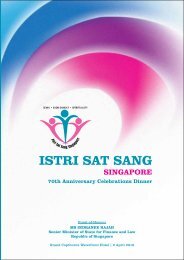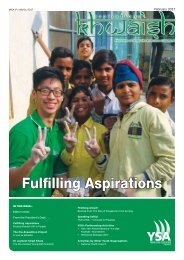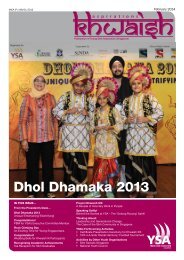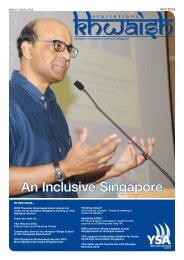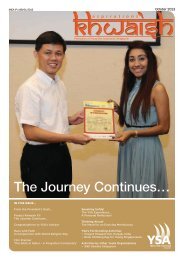Khwaish Oct 2015
You also want an ePaper? Increase the reach of your titles
YUMPU automatically turns print PDFs into web optimized ePapers that Google loves.
Realising the<br />
ASEAN Economic Community<br />
Prospects and Challenges Mr S Pushpanathan<br />
Introduction<br />
The year <strong>2015</strong><br />
is indeed<br />
going to be<br />
a watershed<br />
year for the<br />
Association<br />
of Southeast<br />
Asian Nations<br />
(ASEAN). It is<br />
also the year<br />
of Malaysia’s<br />
Chairmanship<br />
of ASEAN<br />
as ASEAN<br />
makes the<br />
final lap to the<br />
ASEAN community by December <strong>2015</strong>.<br />
The Prime Minister of Malaysia, Dato Sri<br />
Mohd Najib Razak, in his message to the<br />
11th ASEAN Leadership Forum in May<br />
2014 in Myanmar, said that, as the ASEAN<br />
Chair in <strong>2015</strong>, Malaysia would strengthen<br />
people connectivity and make ASEAN a<br />
more people-centred community. He also<br />
said that, the ASEAN community should<br />
evolve to become more people-friendly<br />
and enable the younger generation to have<br />
a better sense of ASEAN consciousness.<br />
ASEAN Economies Today<br />
The growth story of the ASEAN economies<br />
remains strong. ASEAN has a population of<br />
617 million, which is growing at a faster rate<br />
than China and India at an annual average<br />
rate of 1.45 per cent. ASEAN is expected to<br />
achieve an economic growth rate of five to<br />
six per cent from now till 2017. Its combined<br />
gross domestic product (GDP) was about<br />
US$2.4 trillion and total trade stood at<br />
US$2.5 trillion in 2014. ASEAN accounts<br />
for seven per cent of global exports<br />
and its members have developed more<br />
sophisticated manufacturing capabilities<br />
and their exports have diversified. Going<br />
forward, ASEAN is likely to surpass Japan<br />
to be the fourth largest economy by 2030<br />
after the European Union, United States<br />
and China.<br />
In terms of investment, ASEAN is pulling in<br />
about US$128 billion, which is seven times<br />
more than the flow to India and slightly<br />
more than the flow of US$117 billion to<br />
China in 2013. ASEAN also has a higher<br />
rate of return on foreign direct investment<br />
(FDI) at 11 per cent for the period 2005 to<br />
2010 compared to the world’s average of<br />
6.9 per cent and of developing countries at<br />
nine per cent for the same period. ASEAN<br />
is home to 227 of the world’s biggest<br />
companies with more than US$1 billion in<br />
revenue or three per cent of the world’s<br />
total.<br />
In terms of macroeconomic stability, the<br />
region has proven to be resilient in the<br />
aftermath of the 2008 global financial crisis<br />
and has a stronger fiscal position now. It has<br />
certainly learned its lessons from the 1997<br />
Asian financial crisis. Government debt is<br />
under 50 per cent of GDP and savings has<br />
remained steady since 2000 at about a<br />
third of the GDP.<br />
Based on the statistics from the Asian<br />
Development Bank (ADB), the size of the<br />
middle class in ASEAN will rise from 24 per<br />
cent in 2010 to 65 per cent in 2030. By 2017,<br />
the number of middle class households in<br />
ASEAN is expected to reach 85 million, up<br />
from the 40 million registered in 2010. The<br />
number could reach 125 million middleincome<br />
households by 2025 making ASEAN<br />
a key consumer market of the future.<br />
Most strikingly, the region’s under-30<br />
population will account for nearly half of<br />
the total population. As their purchasing<br />
power increases, consumer demand for<br />
educational services, household goods and<br />
services, communications, infrastructure<br />
and energy will also increase.<br />
Besides, extreme poverty is rapidly<br />
declining. In 2000, 14 per cent of the<br />
region’s population was below the<br />
international poverty line of US$1.25 but by<br />
2013, the share has fallen to three per cent.<br />
Urbanisation is another phenomenon<br />
impacting consumer growth and ASEAN<br />
cities are leading this march. Almost 22<br />
per cent of ASEAN’s population now<br />
lives in cities and they account for 54 per<br />
cent of the region’s GDP. An additional<br />
54 million people is expected to move to<br />
cities by 2025. Interestingly, midsize cities<br />
are outpacing the megacities of ASEAN in<br />
leading economic growth. About 40 per<br />
cent of ASEAN’s GDP growth through 2025<br />
is expected to come from 142 cities with a<br />
population of just 200,000 to 5 million.<br />
Progress of AEC Implementation<br />
Thus far, ASEAN has achieved steady<br />
progress under the four pillars of a single<br />
market and production base; a highly<br />
competitive economic region; a region<br />
of equitable economic development; and<br />
a region fully integrated into the global<br />
economy. Based on ASEAN statistics,<br />
ASEAN has achieved about 82.1 per cent<br />
implementation of its priority measures<br />
under the ASEAN Economic Community<br />
(AEC).<br />
The ASEAN Free Trade Area was realised on<br />
1 January 2010. The average intra-ASEAN<br />
preferential tariffs have been reduced to<br />
almost zero with 0.04 per cent remaining<br />
for the more developed ASEAN-6<br />
countries. For CLMV countries (Cambodia,<br />
Laos, Myanmar and Vietnam), the share<br />
of tariff lines at zero per cent preferential<br />
duty has significantly increased to 67.6 per<br />
cent in 2012, with efforts to expedite the<br />
reduction of the remaining tariffs based on<br />
the timelines agreed upon.<br />
A Regional Work Programme on<br />
addressing Non-Tariff Measures has been<br />
adopted and a ASEAN Trade Repository<br />
is to be established to provide detailed<br />
trade related information of all 10 member<br />
countries, which will facilitate not only<br />
intra-ASEAN trade but would also support<br />
ASEAN’s trade with its partners.<br />
ASEAN is in the final stages of implementing<br />
a region-wide self-certification, which will<br />
allow selected registered exporters to<br />
certify export documents on their own.<br />
This will assist the business community to<br />
move goods across the region swiftly and<br />
at reduced costs. It has also completed<br />
the scaled down version of the pilot<br />
stage of the ASEAN Single Window that<br />
seeks to promote a seamless exchange<br />
of electronically transmitted trade related<br />
documents among ASEAN members.<br />
ASEAN is also drafting a legal protocol<br />
to provide the needed assurance for the<br />
businesses to engage in the electronic<br />
exchange of trade documents.<br />
As an integral requirement for making<br />
ASEAN function as a single production base,<br />
the region is now working on harmonisation<br />
of standards and conformance procedures<br />
and discussing or implementing Mutual<br />
Recognition Arrangements (MRAs) in the<br />
priority integration sectors identified by<br />
ASEAN to accelerate the establishment of<br />
the AEC. The sectors include electronics,<br />
automotive, agro-based product,<br />
cosmetics, and traditional medicine and<br />
health supplements.<br />
ASEAN also aims to realise free flow of<br />
services and investment within the region<br />
under the AEC. ASEAN is improving the<br />
environment for ASEAN investors and<br />
service suppliers alike to secure greater<br />
market access and national treatment.<br />
This is being achieved through progressive<br />
or further liberalisation under the ASEAN<br />
Framework Agreement on Services and<br />
the ASEAN Comprehensive Investment<br />
Agreement (ACIA).<br />
Under the ASEAN Framework Agreement<br />
on Services, to date, eight packages<br />
of commitments have been concluded<br />
and the region is now in the process of<br />
finalising the ninth package. Under each<br />
package, the ASEAN member states are<br />
opening up their services sectors for<br />
<strong>Khwaish</strong><br />
9




